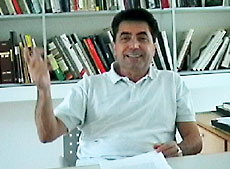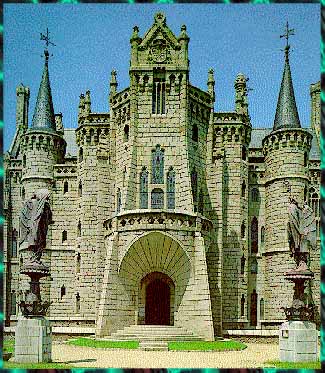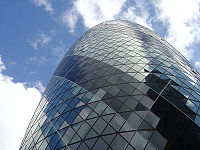Journal One.



from left to right. Fuller with models of geodesic domes; sketch for 4-D towers; Fuller with model for the
Dymaxion House



from left to right: wooden framwork for the Dymaxion Car; Dymaxion Deployment Unit used as emergency accomodation for troops during World War II; Wichita House


from left to right: Autonomous living unit; the US Pavillion at EXPO 67 in Montreal
Journal Two.


Soloman R. Guggenheim Museum New York City
Antoni Gaudi, 1853-1926, was part of the Art Nouveau movement and was famous for his unique style and highly individualistic designs. Gaudi was an ardent Catholic, to the point that in his later years, he abandoned secular work and devoted his life to Catholicism and his Sagrada Familia. He designed it to have 18 towers, 12 for the 12 apostles, 4 for the 4 evangelists, one for Mary and one for Jesus. Soon after, his closest family and friends began to die. His works slowed to a halt, and his attitude changed. On June 7, 1926, Gaudí was run over by a tram.Because of his ragged attire and empty pockets, many cab drivers refused to pick him up for fear that he would be unable to pay the fare. He was eventually taken to a pauper's hospital in Barcelona. Nobody recognized the injured artist until his friends found him the next day. When they tried to move him into a nicer hospital, Gaudí refused, reportedly saying "I belong here among the poor." He died three days later on June 10, 1926, half of Barcelona mourning his death. He was buried in the midst of La Sagrada Familia although Gaudi was constantly changing his mind and recreating his blue prints. The only existing copy of his last recorded blue prints were destroyed by the anarchists in 1938 at the height of Franco's invasion of Barcelona. This has made it very difficult for his workers to complete the cathedral in the same fashion as Gaudí most likely would have wished. It is for this that Gaudí is known to many as "God's Architect". La Sagrada Familia is now being completed but differences between his work and the new additions can be seen.
Episcopal palace of Astorga in Leon
Buckminster Fuller was an American Inventor, architect, philosopher and poet. He theorized Comprehensive Anticipatory Design Science, delineating new global and environmental approaches. He experimented with new materials, anticipated and defended an eco-compatible conception of architecture; invented synergistic geometry; created the geodetic dome, the "Dymaxion Car" and the "Dymaxion House".



from left to right. Fuller with models of geodesic domes; sketch for 4-D towers; Fuller with model for the
Dymaxion House



from left to right: wooden framwork for the Dymaxion Car; Dymaxion Deployment Unit used as emergency accomodation for troops during World War II; Wichita House


from left to right: Autonomous living unit; the US Pavillion at EXPO 67 in Montreal
Journal Two.

The late Aldo Rossi has achieved distinction as a theorist, an author, an artist, a teacher and as a architect, in his native Italy as well as internationally. In Canada, the first Rossi project in the Western Hemisphere was completed in 1987 when the Toronto Lighthouse Theatre was built on the banks of Lake Ontario. At almost the same time period, Rossi's first housing complex was being built on the outskirts of Milan. The Pocono Pines Houses in Pocono, Pennsylvania represent one of his first completed buildings in the United States. In Galveston, Texas,a monumental arch for the city has been completed. In Coral Gables, Florida, the University of Miami has commissioned Rossi to design the new School of Architecture. Five important projects were completed in 1988: the Palazzo Regionale in Perugia (a civic center); a funerary chapel in Giussano built for the Molteni family; a town hall for Borgoricco; the Centro Torri Shopping Center in Parma; and in Turin, Casa Aurora, an office headquarters for GFT, parent company to the designer labels of Valentino, Emanuel Ungaro and Giorgio Armani.He was a very talented architect and is still remembered today.
Journal Three.

Antonio Citterio was born in meda (italy) in 1950. he has a degree in architecture from the polytechnic university in milan, and he opened his studio in 1972. He has collaborated with man italian and foreign firms in the design sector like Ansorg, B&B Italia, Flexform, Flos,Hackmann, Inda, Pozzi e Ginori, Kartell, Arclinea and Vitra. In 1981 he began designing architectural project. From 1987 to 1996 he was associated with Terry Dwan and together they designed many buildings in Europe and Japan. Some of their most important works: the headquarters in Amsterdam, Antwerp and Milan for Esprit, an industrial plant for Vitra in Germany and for Antonio Fusco in Milan. He has won many prizes, among which the compasso d’oro in 1987 and 1995. His products are part of the Moma permanent collection and the centre di pompidouin Paris. He lives and works in Milan.
Journal Three.
David Chipperfield, born in 1953, is an English architect, born in London. He has offices in London, Berlin and Milan, and a representative office in Shanhai. After recieving his diploma from the Architectural Association in London he worked at the practices of Douglas Stephen, Richard Rogers and Norman Foster and in 1984 established his own practice, David Chipperfield Architects. David Chipperfield was awarded the Tessenow Gold Medal. In 2000 he was one of the architects to represent Britain at the Venice Biennale of Architecture. Chipperfield is the architect for the reconstruction of the destroyed Neues Museum in Berlin, due to reopen in 2009.
Journal Four.
Not only did Charles Eames and his wife, Ray, design some of the most important examples of 20th century furnitre, they also applied their talents to children's toys, puzzles, films, exhibitions and such iconic mid-20th century Los Angeles buildings as the Eames House and Entenza House in Pacific Palisades. Below are some examples of some of the works they have designed and are seen in many places still today.
Journal Five.
Frank Lloyd Wright was one of the most influential architects of the twentieth century. From his early Praire Style homes, to the sculptural curves of the Guggenheim Museum in New York. He was a founder of modern architecture in North America. He embraced the use of new technology, materials and engineering to create some of the twentieth century's most influential buildings. During his seventy year career span he designed over one thousand buildings of which over four-hundred were built. Below are some examples of work he has designed all over the world.
Frederick C. Robie House Chicago, Illinois
Frederick C. Robie House Chicago, Illinois
Imperial Hotel Tokyo, Japan
Soloman R. Guggenheim Museum New York City
Interior of the Solomon R. Guggenheim Museum
Journal Six.
Antoni Gaudi, 1853-1926, was part of the Art Nouveau movement and was famous for his unique style and highly individualistic designs. Gaudi was an ardent Catholic, to the point that in his later years, he abandoned secular work and devoted his life to Catholicism and his Sagrada Familia. He designed it to have 18 towers, 12 for the 12 apostles, 4 for the 4 evangelists, one for Mary and one for Jesus. Soon after, his closest family and friends began to die. His works slowed to a halt, and his attitude changed. On June 7, 1926, Gaudí was run over by a tram.Because of his ragged attire and empty pockets, many cab drivers refused to pick him up for fear that he would be unable to pay the fare. He was eventually taken to a pauper's hospital in Barcelona. Nobody recognized the injured artist until his friends found him the next day. When they tried to move him into a nicer hospital, Gaudí refused, reportedly saying "I belong here among the poor." He died three days later on June 10, 1926, half of Barcelona mourning his death. He was buried in the midst of La Sagrada Familia although Gaudi was constantly changing his mind and recreating his blue prints. The only existing copy of his last recorded blue prints were destroyed by the anarchists in 1938 at the height of Franco's invasion of Barcelona. This has made it very difficult for his workers to complete the cathedral in the same fashion as Gaudí most likely would have wished. It is for this that Gaudí is known to many as "God's Architect". La Sagrada Familia is now being completed but differences between his work and the new additions can be seen.
Casa Mila in Barcelona,Spain

Cathedral La Sagrada Familia in Barcelona,Spain
Journal Seven
Housing Complex "In the Meadows", Bad Soden, Taunus

Cathedral La Sagrada Familia in Barcelona,Spain
Journal Seven
Friendensreich Hundertwasser's original, shocking artistic vision expressed itself in art, environmentalism, and design of facades, postage stamps, flags, and clothing. The common themes in his work are a rejection of the straight line, bright colors, organic forms, a reconciliation of humans with nature, and a strong individualism. His work is comparable to Antoni Gaudi in his use of tile. He felt that standard architecture could not be called art, and declared that the design of any building should be influenced by the aesthetics of its eventual tenants.
Housing Complex "In the Meadows", Bad Soden, Taunus
Motorway Restauran, Bad Fischau

Living Beneath the Rain Tower, Plochingen

Integrative School, Heddernheim

Rogner-Bad Blumau, Hotel and Spa
Journal Eight.
In 1959 when Isaiah Zagar was 19 years old he was introduced to the folk art environment of Clarence Schmidt, My Mirrored Hope, Woodstock, NY USA. Soon after in 1960 there was a groundbreaking exhibition at the Museum of Modern Art, NY USA. Because that exhibition included assemblages of artists like Pablo Picasso, Jean Dubuffet, Curt Schwitters, Antonio Gaudi along side of untrained brickaleurs Clarence Schmit, Simon Rodia and Joseph Ferdinand Cheval that gave Isaiah as a trained artist the rationale to include their concepts as manifestations of fine art. At a crucial time in my life it allowed me to begin what could be called a life's work making the city of Philadelphia PA USA into a labyrinthine mosaic museum that incorporates all his varied knowledge and skills.


Living Beneath the Rain Tower, Plochingen

Integrative School, Heddernheim

Rogner-Bad Blumau, Hotel and Spa
Journal Eight.
In 1959 when Isaiah Zagar was 19 years old he was introduced to the folk art environment of Clarence Schmidt, My Mirrored Hope, Woodstock, NY USA. Soon after in 1960 there was a groundbreaking exhibition at the Museum of Modern Art, NY USA. Because that exhibition included assemblages of artists like Pablo Picasso, Jean Dubuffet, Curt Schwitters, Antonio Gaudi along side of untrained brickaleurs Clarence Schmit, Simon Rodia and Joseph Ferdinand Cheval that gave Isaiah as a trained artist the rationale to include their concepts as manifestations of fine art. At a crucial time in my life it allowed me to begin what could be called a life's work making the city of Philadelphia PA USA into a labyrinthine mosaic museum that incorporates all his varied knowledge and skills.

West wall top of Waters Memorial Community Center

Carlos Carpets Facade

Detailed view

The Hearst Tower in New York City


Carlos Carpets Facade

Detailed view
Journal Nine.
Foster was born in England and naturally gifted in architecture, particularly in the works of Frank Lloyd Wright and Le Corbusier. He left school at age 16 to work in the Manchester City Treasurer's office before joining the Royal Air Force. After discharged, Foster attended the University of Manchester's School of Architecture. Later he won the Henry Fellowship to the Yale School of Architecture, where he met his former business partner Richard Rogers and earned his Master's. He traveled for about a year in America then returned to the UK where he set up an architectural practice as Team 4 with Rogers and their wives Wendy Cheesman and Sue Rogers. They soon earned a reputation for high-tech industrial design.

The Hearst Tower in New York City

30 St Mary Axe a.k.a. "The Gherkin" in London
Journal Ten.

Chapel in Ronchamp, France

Key French Building in Paris
Journal Ten.
Le Corbusier was a Swiss-born architect and writer, who is famous for his contributions to what now is called Modern Architecture. He was a pioneer in theoretical studies of modern design and was dedicated to providing better living conditions for the residents of crowded cities. His career spanned five decades, with buildings constructed throughout central Europe, India, Russia, and one structure each in North and South America. He was also an urban planner, painter, sculptor, writer, and modern furniture designer.

Chapel in Ronchamp, France

Key French Building in Paris

















No comments:
Post a Comment